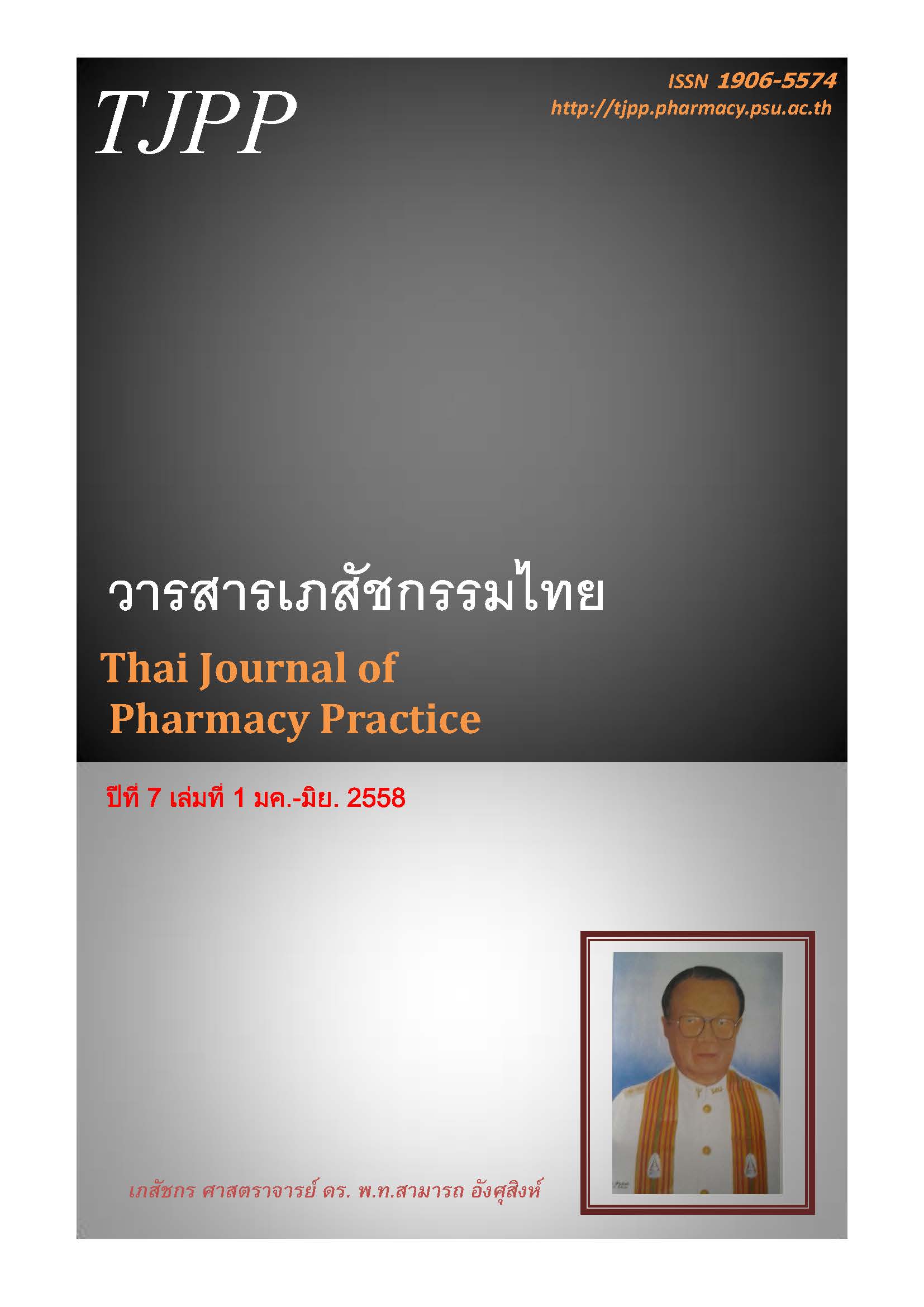ความรู้และความคิดเห็นของเภสัชกรโรงพยาบาลที่มีต่อยาชีววัตถุและไบโอซิมิลาร์
Main Article Content
บทคัดย่อ
วัตถุประสงค์: เพื่อศึกษาความรู้ ความคิดเห็น และการบริหารจัดการต่อยาชีววัตถุและไบโอซิมิลาร์ ของเภสัชกรโรงพยาบาล วิธีการวิจัย: งานวิจัยเชิงพรรณนาแบบภาคตัดขวาง โดยส่งแบบสอบถามทางไปรษณีย์ไปยังเภสัชกรโรงพยาบาล 524 รายทั่วประเทศระหว่างกรกฎาคม ถึง สิงหาคม 2556 เพื่อสอบถามข้อมูลเกี่ยวกับความรู้ ความคิดเห็น และความต้องการการสนับสนุนเกี่ยวกับยาชีววัตถุและไบโอซิมิลาร์ ผลการวิจัย: ตัวอย่างส่งแบบสอบถามกลับ 306 ฉบับ (ร้อยละ 58.40) โรงพยาบาลศูนย์ตอบกลับสูงสุดคิดเป็นร้อยละ 80.00 ขณะที่โรงพยาบาลเอกชนตอบกลับน้อยที่สุด คือ ร้อยละ 43.01 กลุ่มตัวอย่างร้อยละ 80.86 เคยได้ข้อมูลเกี่ยวกับยาชีววัตถุ แต่ร้อยละ 54.13 เคยได้ข้อมูลเรื่องไบโอซิมิลาร์ มากกว่าร้อยละ 80 ตอบถูกในเรื่องการเก็บรักษาและปัจจัยสำคัญที่ควรใช้พิจารณาคุณภาพของยาชีววัตถุ แต่น้อยกว่าร้อยละ 50 ตอบถูกเกี่ยวกับไบโอซิมิลาร์ มากกว่าร้อยละ 90 เห็นด้วยว่าเภสัชกรยังขาดความเข้าใจเรื่องไบโอซิมิลาร์ โดยไม่แน่ใจในเรื่องของประสิทธิภาพและความปลอดภัยของยา ร้อยละ 70 มีแนวปฏิบัติเกี่ยวกับยาชีววัตถุ แต่ยังไม่มีความชัดเจนเรื่องแนวปฏิบัติเกี่ยวกับการคัดเลือกไบโอซิมิลาร์ เภสัชกรเพศชายมีความรู้เกี่ยวกับยาชีววัตถุและไบโอซิมิลาร์ มากกว่าเพศหญิงโดยมี OR = 1.81 (1.03-3.18) เภสัชกรที่ปฏิบัติงานในโรงพยาบาลทั่วไปมีความรู้มากกว่าผู้ปฏิบัติงานในโรงพยาบาลเอกชน OR = 2.96 (1.21-7.25) และเภสัชกรที่ได้รับข้อมูลมาก่อนมีความรู้มากกว่าผู้ที่ไม่ได้รับข้อมูล OR = 1.29 (1.64-2.60) สรุป: เภสัชกรโรงพยาบาลส่วนใหญ่มีความรู้พื้นฐานเกี่ยวกับยาชีววัตถุ แต่ยังขาดความรู้เรื่องไบโอซิมิลาร์ ทำให้เภสัชกรขาดความมั่นใจในการเปรียบเทียบคุณลักษณะของยาระหว่างยาชีววัตถุต้นแบบและไบโอซิมิลาร์
Article Details
ผลการวิจัยและความคิดเห็นที่ปรากฏในบทความถือเป็นความคิดเห็นและอยู่ในความรับผิดชอบของผู้นิพนธ์ มิใช่ความเห็นหรือความรับผิดชอบของกองบรรณาธิการ หรือคณะเภสัชศาสตร์ มหาวิทยาลัยสงขลานครินทร์ ทั้งนี้ไม่รวมความผิดพลาดอันเกิดจากการพิมพ์ บทความที่ได้รับการเผยแพร่โดยวารสารเภสัชกรรมไทยถือเป็นสิทธิ์ของวารสารฯ
เอกสารอ้างอิง
2. Tredree R. Drugs of the 21st century: Biopharmaceuticals and biosimilars. Eur J Hosp Pharm Pract. 2007;13:26-7.
3. Rickwood S, Di Biase S. IMS health biosimilars and non-original biologics. 2013 [cited June 20, 2014]; Available from: http://www.imshealth.com/de ployedfiles/imshealth/Global/Content/Healthcare/Life%20Sciences%20Solutions/Generics/IMSH_Biosimilars_WP.pdf.
4. McCamish M, Woollett G. Worldwide experience with biosimilar development. mAbs. 2011;3:209-17.
5. Sharma B. Immunogenicity of therapeutic proteins. Part 1: Impact of product handling. Biotechnol Adv. 2007; 25: 310-7.
6. Krämer I, Sauer T. The new world of biosimilars: what diabetologists need to know about biosimilar insulins. Br J of Diabetes and Vascular Disease. 2010;10: 163-71.
7. Kromminga A, Schellekens H. Antibodies against erythropoietin and other protein-based therapeutics : an overview. Ann NY Acad Sci. 2005;1050: 257-65. Epub 2005/07/15.
8. Schellekens H. Immunogenicity of therapeutic proteins: clinical implications and future prospects. Clin Ther. 2002;24:1720-40.
9. Schellekens H. Bioequivalence and the immunege- nicity of biopharmaceuticals. Nat Rev Drug Discov. 2002;1:457-62. Epub 2002/07/18.
10. Baker MP, Reynolds HM, Lumicisi B, Bryson CJ. Immunogenicity of protein therapeutics: The key causes, consequences and challenges. Self Nonself. 2010; 1: 314-22. Epub 2011/04/14.
11. Casadevall N, Nataf J, Viron B, Kolta A, Kiladjian JJ, Martin-Dupont P, et al. Pure red-cell aplasia and antierythropoietin antibodies in patients treated with recombinant erythropoietin. N Engl J Med. 2002;346: 469-75.
12. Casadevall N. Pure red cell aplasia and anti-erythropoietin antibodies in patients treated with epoetin. Nephrol Dial Transplant. 2003;18: viii37-41.
13. Praditpornsilpa K, Tiranathanagul K, Kupatawintu P, Jootar S, Intragumtornchai T, Tungsanga K, et al. Biosimilar recombinant human erythropoietin induces the production of neutralizing antibodies. Kidney Int. 2011; 80: 88-92.
14. Gershon S, Luksenburg H, Coté T, Braun M. Pure red-cell aplasia and recombinant erythropoietin. N Engl J Med. 2002; 346:1584-6.
15. Keithi-Reddy SR, Kandasamy S, Singh AK. Pure red cell aplasia due to follow-on epoetin. Kidney Int. 2008;74:1617-22.
16. Schellekens H. Biosimilar therapeutic agents: issues with bioequivalence and immunogenicity. Eur J Clin Invest. 2004;34: 797-9.
17. Schellekens H. How similar do 'biosimilars' need to be? Nat biotechnol. 2004;22:1357-9.
18. Zelenetz AD, Ahmed I, Braud EL, Cross JD, Davenport-Ennis N, Dickinson BD, et al. NCCN biosimilars white paper: regulatory, scientific, and patient
safety perspectives. J Natl Compr Canc Netw. 2011;9:S1-22.
19. ASHP Advantage. A health-system pharmacist’s guide to biosimilars: regulatory, scientific, and practical considerations. [cited July 13, 2014.]; Available from: http://ashpadvantagemedia.com/downloads/biosimcentral_guidelines.pdf.
20. Thai Food and Drug Administration. (draft) Guideline on evaluation of similar biological medicinal products. [cited Dec 10, 2014]; Available from: http://www.fda.moph.go.th/News55/Drug/ biosimilars(draft).pdf.
21. Bureau of Drug Control. Thai Food and Drug Administration. Guideline on evaluation of similar biological medicinal products. 2013. [cited June 18, 2014]; Available from: http://drug.fda.moph.go. th/zone_law/files/d4.pdf.
22. GaBI Online. Biosimilars approved in Europe.: Mol, Belgium: Pro Pharma Communications Interna- tional; [June 19, 2014]; Available from: http://www. gabionline.net/Biosimilars/General/Biosimilars-approved-in-Europe.
23. Boone N, Kuy Hvd, Scott M, Mairs J, Krämer I, Vulto A, et al. How to select a biosimilar. Eur J Hosp Pharm. 2013;20:275-86.
24. Lucio S. Clinical and Formulary Considerations for Biosimilars. Hosp Pharm. 2014; 49(Suppl 1):S6-S12.
25. Malcom DR, Al-Ghananeem AM. Biotechnology in practice: call for incorporation of biosimilars into pharmacy education, currents in pharmacy teaching and learning. Curr Pharm Teach Learn. 2015; 7: 256-8.


